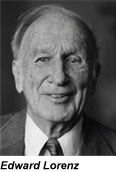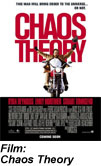 The first true experimenter in chaos was meteorologist, Edward Lorenz. He tried to explain why it is so hard to make good weather forecasts and wound up unleashing a scientific revolution called chaos theory.
The first true experimenter in chaos was meteorologist, Edward Lorenz. He tried to explain why it is so hard to make good weather forecasts and wound up unleashing a scientific revolution called chaos theory.
Chaos theory: In a scientific context, the word chaos has a slightly different meaning than it does in its general usage as a state of confusion, lacking any order. Chaos, with reference to chaos theory, refers to an apparent lack of order in a system that nevertheless obeys particular laws or rules; this understanding of chaos is synonymous with dynamical instability, a condition discovered by the physicist Henri Poincare in the early 20th century that refers to an inherent lack of predictability in some physical systems.
The two main components of chaos theory are the ideas that systems – no matter how complex they may be – rely upon an underlying order, and that very simple or small systems and events can cause very complex and unexpected behaviors or events. This latter idea is known as sensitive dependence on initial conditions, a circumstance discovered by Edward Lorenz (who is generally credited as the first experimenter in the area of chaos) in the early 1960s.
Lorenz was using a series of twelve mathematical equations to try accurately to model weather patterns. Experimenting with data collected from weather stations, he ran a series of computer programs to test his model. Occasionally he would repeat an experiment. On one such occasion, instead of re-entering all the data he truncated the number .506127 to .506 and ran his program using this approximate value. To his amazement the new results were totally different. A very small change in his input data could result in a major change to his predictions. In addition, these changes appeared to be random in nature.

These observations ultimately led him to formulate what became known as the butterfly effect–a term that grew out of an academic paper he presented in 1972 entitled: “Predictability: Does the Flap of a Butterfly’s Wings in Brazil Set Off a Tornado in Texas?”
Lorenz’s discovery shocked the scientific world. Chaotic systems soon began to be recognized in all branches of science–biological, physical and social. As mathematicians started to unravel its mysteries, science reeled before the implications of an uncertain world intricately bound up with chance. The human heartbeat is chaotic, the stock market, the solar system and of course the weather. In fact the more we learn about chaos the more closely it seems to be bound up with nature. Fractal structures seem to be everywhere we look: in ferns, cauliflowers, the coral reef, kidneys… Rather than turn its back on chaos, nature appears to use it, and science is beginning to do the same.
Recent Film:
An example of Chaos Theory at work in our daily lives is the 2007 Warner Bros. film Chaos Theory.











